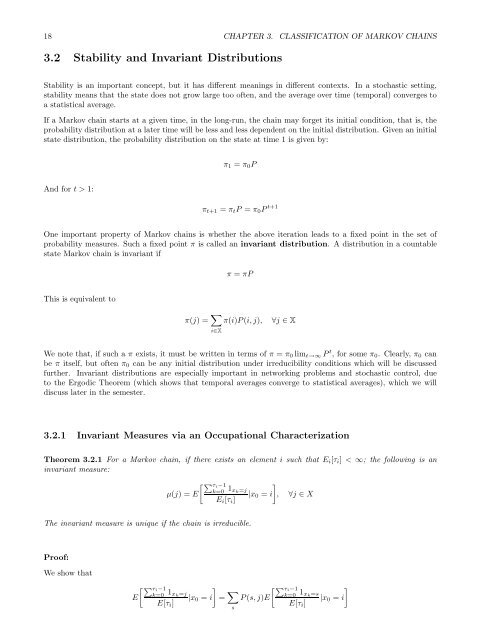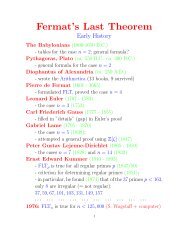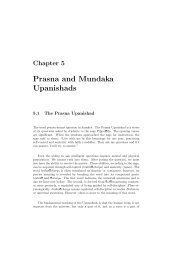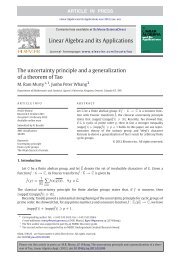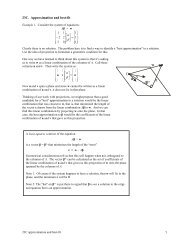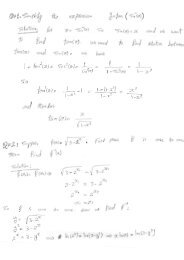Lecture Notes - Department of Mathematics and Statistics - Queen's ...
Lecture Notes - Department of Mathematics and Statistics - Queen's ...
Lecture Notes - Department of Mathematics and Statistics - Queen's ...
Create successful ePaper yourself
Turn your PDF publications into a flip-book with our unique Google optimized e-Paper software.
18 CHAPTER 3. CLASSIFICATION OF MARKOV CHAINS<br />
3.2 Stability <strong>and</strong> Invariant Distributions<br />
Stability is an important concept, but it has different meanings in different contexts. In a stochastic setting,<br />
stability means that the state does not grow large too <strong>of</strong>ten, <strong>and</strong> the average over time (temporal) converges to<br />
a statistical average.<br />
If a Markov chain starts at a given time, in the long-run, the chain may forget its initial condition, that is, the<br />
probability distribution at a later time will be less <strong>and</strong> less dependent on the initial distribution. Given an initial<br />
state distribution, the probability distribution on the state at time 1 is given by:<br />
π 1 = π 0 P<br />
And for t > 1:<br />
π t+1 = π t P = π 0 P t+1<br />
One important property <strong>of</strong> Markov chains is whether the above iteration leads to a fixed point in the set <strong>of</strong><br />
probability measures. Such a fixed point π is called an invariant distribution. A distribution in a countable<br />
state Markov chain is invariant if<br />
π = πP<br />
This is equivalent to<br />
π(j) = ∑ i∈X<br />
π(i)P(i, j), ∀j ∈ X<br />
We note that, if such a π exists, it must be written in terms <strong>of</strong> π = π 0 lim t→∞ P t , for some π 0 . Clearly, π 0 can<br />
be π itself, but <strong>of</strong>ten π 0 can be any initial distribution under irreducibility conditions which will be discussed<br />
further. Invariant distributions are especially important in networking problems <strong>and</strong> stochastic control, due<br />
to the Ergodic Theorem (which shows that temporal averages converge to statistical averages), which we will<br />
discuss later in the semester.<br />
3.2.1 Invariant Measures via an Occupational Characterization<br />
Theorem 3.2.1 For a Markov chain, if there exists an element i such that E i [τ i ] < ∞; the following is an<br />
invariant measure:<br />
[∑ τi−1<br />
k=0<br />
µ(j) = E<br />
1 ]<br />
x k =j<br />
|x 0 = i , ∀j ∈ X<br />
E i [τ i ]<br />
The invariant measure is unique if the chain is irreducible.<br />
Pro<strong>of</strong>:<br />
We show that<br />
[∑ τi−1<br />
k=0<br />
E<br />
1 ]<br />
x k =j<br />
|x 0 = i<br />
E[τ i ]<br />
= ∑ s<br />
[∑ τi−1<br />
k=0<br />
P(s, j)E<br />
1 ]<br />
x k =s<br />
|x 0 = i<br />
E[τ i ]


